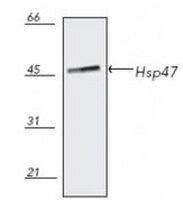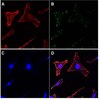386023 Sigma-AldrichAnti-Hsp47 Mouse mAb (M16.10A1)
Anti-Hsp47, mouse monoclonal, clone M16.10A1, recognizes the ~47 kDa Hsp47 protein in wide variety of species. It is validated for use in ELISA, EIA, WB, ICC, IF, IP, and IHC (paraffin sections).
More>> Anti-Hsp47, mouse monoclonal, clone M16.10A1, recognizes the ~47 kDa Hsp47 protein in wide variety of species. It is validated for use in ELISA, EIA, WB, ICC, IF, IP, and IHC (paraffin sections). Less<<Synonyms: Anti-Colligin
Recommended Products
Overview
| Replacement Information |
|---|
Key Specifications Table
| Species Reactivity | Host | Antibody Type |
|---|---|---|
| B, Ca, Ch, Gp, Ht, H, Mk, M, Porcine, R, Sh | M | Monoclonal Antibody |
Products
| Catalog Number | Packaging | Qty/Pack | |
|---|---|---|---|
| 386023-50UG | Plastic ampoule | 50 μg |
| Product Information | |
|---|---|
| Form | Liquid |
| Formulation | In PBS, 50% glycerol, pH 7.2. |
| Positive control | 3T3 cells, Human breast cancer tissue |
| Preservative | ≤0.1% sodium azide |
| Quality Level | MQ100 |
| Physicochemical Information |
|---|
| Dimensions |
|---|
| Materials Information |
|---|
| Toxicological Information |
|---|
| Safety Information according to GHS |
|---|
| Safety Information |
|---|
| Product Usage Statements |
|---|
| Packaging Information |
|---|
| Transport Information |
|---|
| Supplemental Information |
|---|
| Specifications |
|---|
| Global Trade Item Number | |
|---|---|
| Catalog Number | GTIN |
| 386023-50UG | 04055977189872 |
Documentation
Anti-Hsp47 Mouse mAb (M16.10A1) SDS
| Title |
|---|
Anti-Hsp47 Mouse mAb (M16.10A1) Certificates of Analysis
| Title | Lot Number |
|---|---|
| 386023 |
References
| Reference overview |
|---|
| Kuroda, K., et al. 1998. J. Invest. Dermatol. 111, 1023. Nandan, D., et al. 1998. Exp. Cell Res. 179, 289. Clark, E.P., et al. 1991. J. Biol. Chem. 266, 17230. Vaillancourt, J.P., and Cates, G.A. 1991. Biochem. J. 274, 793. Cates, G.A., et al. 1987. Biochem. Cell Biol. 65, 767. Saga, S., et al. 1987. J. Cell Biol. 105, 517. Nagata, K., et al. 1986. J. Biol. Chem. 261, 7531. |
















